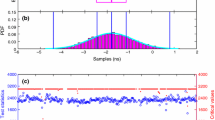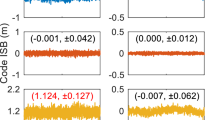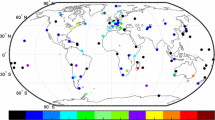Abstract
As a first step towards studying the ionosphere with the global navigation satellite system (GNSS), leveling the phase to the code geometry-free observations on an arc-by-arc basis yields the ionospheric observables, interpreted as a combination of slant total electron content along with satellite and receiver differential code biases (DCB). The leveling errors in the ionospheric observables may arise during this procedure, which, according to previous studies by other researchers, are due to the combined effects of the code multipath and the intra-day variability in the receiver DCB. In this paper we further identify the short-term temporal variations of receiver differential phase biases (DPB) as another possible cause of leveling errors. Our investigation starts by the development of a method to epoch-wise estimate between-receiver DPB (BR-DPB) employing (inter-receiver) single-differenced, phase-only GNSS observations collected from a pair of receivers creating a zero or short baseline. The key issue for this method is to get rid of the possible discontinuities in the epoch-wise BR-DPB estimates, occurring when satellite assigned as pivot changes. Our numerical tests, carried out using Global Positioning System (GPS, US GNSS) and BeiDou Navigation Satellite System (BDS, Chinese GNSS) observations sampled every 30 s by a dedicatedly selected set of zero and short baselines, suggest two major findings. First, epoch-wise BR-DPB estimates can exhibit remarkable variability over a rather short period of time (e.g. 6 cm over 3 h), thus significant from a statistical point of view. Second, a dominant factor driving this variability is the changes of ambient temperature, instead of the un-modelled phase multipath.





Similar content being viewed by others
References
Azpilicueta F, Brunini C, Radicella S (2006) Global ionospheric maps from GPS observations using modip latitude. Adv Space Res 38:2324–2331
Brunini C, Azpilicueta F (2010) GPS slant total electron content accuracy using the single layer model under different geomagnetic regions and ionospheric conditions. J Geod 84:293–304
Brunini C, Azpilicueta F (2009) Accuracy assessment of the GPS-based slant total electron content. J Geod 83:773–785
Bruyninx C, Defraigne P, Sleewaegen J-M (1999) Time and frequency transfer using GPS codes and carrier phases: onsite experiments. GPS Solut 3(2):1–10
Chen C, Saito A, Lin C, Yamamoto M, Suzuki S, Seemala G (2016) Medium-scale traveling ionospheric disturbances by three-dimensional ionospheric GPS tomography. Earth Planets Space 68:32. doi:10.1186/s40623-016-0412-6
Ciraolo L, Azpilicueta F, Brunini C, Meza A, Radicella S (2007) Calibration errors on experimental slant total electron content (TEC) determined with GPS. J Geod 81:111–120
Coster A, Williams J, Weatherwax A, Rideout W, Herne D (2013) Accuracy of GPS total electron content: GPS receiver bias temperature dependence. Radio Sci 48:190–196
Debao W, Xiao Z, Yangjin T, Guangsheng Z, Min Z, Rusong L (2015) GPS-based ionospheric tomography with a constrained adaptive simultaneous algebraic reconstruction technique. J Earth Syst Sci 124:283–289
Dettmering D, Schmidt M, Heinkelmann R, Seitz M (2011) Combination of different space-geodetic observations for regional ionosphere modeling. J Geod 85:989–998
Dyrud L, Jovancevic A, Brown A, Wilson D, Ganguly S (2008) Ionospheric measurement with GPS: receiver techniques and methods. Radio Sci 43(6):RS6002. doi:10.1029/2007RS003770
Georgiadou Y, Kleusberg A (1988) On carrier signal multipath effects in relative GPS positioning. Manus Geod 13:172–179
Hartinger H, Brunner F (1999) Variances of GPS phase observations: the SIGMA-\(\varepsilon \) model. GPS Solut 2:35–43
Hernández-Pajares M, Juan J, Sanz J (1999) New approaches in global ionospheric determination using ground GPS data. J Atmos Sol Terr Phys 61:1237–1247
Jin S, Jin R, Li D (2016) Assessment of BeiDou differential code bias variations from multi-GNSS network observations. Ann Geophys 34(2):259–269
Kao S, Tu Y, Chen W, Weng D, Ji S (2013) Factors affecting the estimation of GPS receiver instrumental biases. Surv Rev 45:59–67
Komjathy A, Galvan DA, Stephens P, Butala MD, Akopian V, Wilson B, Verkhoglyadova O, Mannucci AJ, Hickey M (2012) Detecting ionospheric TEC perturbations caused by natural hazards using a global network of GPS receivers: the Tohoku case study. Earth Planets Space 64:1287–1294
Li H, Zhou X, Wu B (2013) Fast estimation and analysis of the inter-frequency clock bias for Block IIF satellites. GPS Solut 17:347–355
Li M, Yuan Y, Wang N, Li Z, Li Y, Huo X (2016) Estimation and analysis of Galileo differential code biases. J Geod. doi:10.1007/s00190-016-0962-1
Li Z, Yuan Y, Li H, Ou J, Huo X (2012) Two-step method for the determination of the differential code biases of COMPASS satellites. J Geod 86:1059–1076
Li Z, Yuan Y, Wang N, Hernandez-Pajares M, Huo X (2015) SHPTS: towards a new method for generating precise global ionospheric TEC map based on spherical harmonic and generalized trigonometric series functions. J Geod 89:331–345
Liu L, Wan W (2016) New understanding achieved from 2 years of Chinese ionospheric investigations. Sci Bull 61:524–542
Liu Z, Gao Y (2004) Ionospheric TEC predictions over a local area GPS reference network. GPS Solut 8:23–29
Mannucci A, Wilson B, Yuan D, Ho C, Lindqwister U, Runge T (1998) A global mapping technique for GPS-derived ionospheric total electron content measurements. Radio Sci 33:565–582
Montenbruck O, Hauschild A, Steigenberger P, Hugentobler U, Teunissen P, Nakamura S (2013) Initial assessment of the COMPASS/BeiDou-2 regional navigation satellite system. GPS Solut 17:211–222
Montenbruck O, Hugentobler U, Dach R, Steigenberger P, Hauschild A (2012) Apparent clock variations of the Block IIF-1 (SVN62) GPS satellite. GPS Solut 16:303–313
Nadarajah N, Teunissen PJ, Raziq N (2013) BeiDou inter-satellite-type bias evaluation and calibration for mixed receiver attitude determination. Sensors 13:9435–9463
Ping J et al (2002) Regional ionosphere map over Japanese Islands. Earth Planets Space 54:e13–e16
Sardon E, Rius A, Zarraoa N (1994) Estimation of the transmitter and receiver differential biases and the ionospheric total electron content from global positioning system observations. Radio Sci 29:577–586
Shi C et al (2012) Precise orbit determination of BeiDou Satellites with precise positioning. Sci China Earth Sci 55:1079–1086
Stephens P, Komjathy A, Wilson B, Mannucci A (2011) New leveling and bias estimation algorithms for processing COSMIC/FORMOSAT-3 data for slant total electron content measurements. Radio Sci 46(6):RS0D10. doi:10.1029/2010RS004588
Tang L, Zhang X, Li Z (2015) Observation of ionospheric disturbances induced by the 2011 Tohoku tsunami using far-field GPS data in Hawaii. Earth Planets Space 67:88. doi:10.1186/s40623-015-0240-0
Tang W, Jin L, Xu K (2014) Performance analysis of ionosphere monitoring with BeiDou CORS observational data. J Navig 67:511–522
Teunissen P, De Jonge P, Tiberius C (1997) The least-squares ambiguity decorrelation adjustment: its performance on short GPS baselines and short observation spans. J Geod 71:589–602
Teunissen PJ (1995) The least-squares ambiguity decorrelation adjustment: a method for fast GPS integer ambiguity estimation. J Geod 70:65–82
Wang M, Gao Y (2001) An investigation on GPS receiver initial phase bias and its determination. In: Proceedings of the 2007 national technical meeting of the institute of navigation, pp 873–880
Xue J, Song S, Zhu W (2015) Estimation of differential code biases for Beidou navigation system using multi-GNSS observations: how stable are the differential satellite and receiver code biases? J Geod 90(4):309–321
Yang Y, Li J, Xu J, Tang J, Guo H, He H (2011) Contribution of the compass satellite navigation system to global PNT users. Chin Sci Bull 56:2813–2819
Yao Y, Chen P, Zhang S, Chen J (2013) A new ionospheric tomography model combining pixel-based and function-based models. Adv Space Res 52:614–621
Yunbin Y et al (2015) Monitoring the ionosphere based on the Crustal Movement Observation Network of China. Geod Geodyn 6(2):73–80
Zhang B, Teunissen PJG (2015) Characterization of multi-GNSS between-receiver differential code biases using zero and short baselines. Sci Bull 60:1840–1849
Zhang R, Song W, Yao Y, Shi C, Lou Y, Yi W (2015) Modeling regional ionospheric delay with ground-based BeiDou and GPS observations in China. GPS Solut 19:649–658
Zhong J, Lei J, Dou X, Yue X (2015) Is the long-term variation of the estimated GPS differential code biases associated with ionospheric variability? GPS Solut. doi:10.1007/s10291-015-0437-5
Acknowledgements
This work was partially funded by the CAS/KNAW joint research project “Compass, Galileo and GPS for Improved Ionosphere Modelling”, the Positioning Program Project 1.19 “Multi-GNSS PPP-RTK Network Processing” of the Cooperative Research Centre for Spatial Information (CRC-SI), the National key Research Program of China “Collaborative Precision Positioning Project” (No. 2016YFB0501900) and the National Natural Science Foundation of China (Nos. 41604031, 41374043, 41574015). The first author is supported by the CAS Pioneer Hundred Talents Program. The second author is the recipient of an Australian Research Council (ARC) Federation Fellowship (Project Number FF0883188). All this support is gratefully acknowledged.
Author information
Authors and Affiliations
Corresponding author
Rights and permissions
About this article
Cite this article
Zhang, B., Teunissen, P.J.G. & Yuan, Y. On the short-term temporal variations of GNSS receiver differential phase biases. J Geod 91, 563–572 (2017). https://doi.org/10.1007/s00190-016-0983-9
Received:
Accepted:
Published:
Issue Date:
DOI: https://doi.org/10.1007/s00190-016-0983-9




